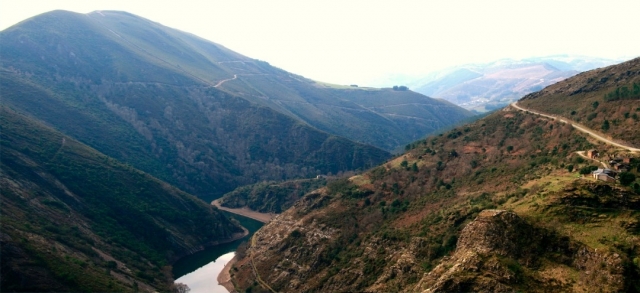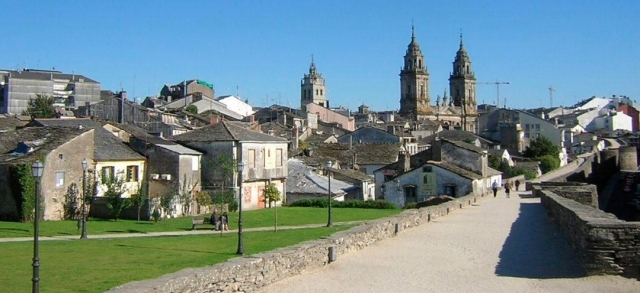The Primitive Way; the oldest and most demanding route to Santiago
Those pilgrims who want to get away from the modifications of the French Way, looking for an authentic route and much more unknown, will not be disappointed by the Primitive Way.
Primitive Way: Following the footsteps of the first pilgrims to Santiago
The Primitive Way is the millennial union of two capital cities for the history of the Jacobean routes: Oviedo and Santiago de Compostela. Two cities originally linked by the will of a medieval king and that we can precisely find a monument in the form of a statue in Oviedo (next to the cathedral) and Santiago (in the historic center). This king is none other than Alfonso II, considered as the first pilgrim after traveling at the beginning of the ninth century from the seat of his court to the exact place where the remains of the Apostle Santiago were supposed to have been found.
Alfonso II of Asturias controlled during a reign that lasted many decades the territory that today we know like Asturias, Galicia and Leon, obtaining important victories controls the Muslims in the north of the peninsula. However its name also went down in history to become the initiator of the pilgrimages to Santiago de Compostela, that originally passed crossing the western part of Asturias and passing through the walled city of Lugo to arrive at holy city. Alfonso and his court would take the first steps along the Primitivo Way to Santiago to visit the alleged remains of the Apostle Santiago, a route that today retains its layout faithfully and for which more than a thousand years ago Christians from all over Europe walked.
The Primitive Way has the honor of being the original Jacobean route, a road of kings, however more than a century after the first pilgrimages to Santiago de Compostela, with the advance toward the south of the Reconquest, it was relegated to the background . The route that we know today as Camino Francéss and that crosses the peninsula from east to west connecting Roncesvalles with Santiago, became a more friendly option for the pilgrim, becoming a vital commercial route for all Europe in the Middle Ages.
A route with exceptional landscaping
More than 1200 years after the first journey of the King of Asturias, the Primitive Way is a magnificent option for all pilgrims looking for an alternative route, leaving aside masses, in contact with nature and after the original Jacobean spirit. The Primitive Way part of Oviedo and takes the pilgrim through one of the lesser known areas of Asturias, its western interior, where all its councils cross to reach the province of Lugo through Alto do Acevo, more than 1,000 meters high. Like Alfonso II king of Asturias the pilgrims will arrive at the walled city of Lugo and continue their way until Melide, where the Primitivo joins the French Way, traced with which it shares three stages until Santiago de Compostela.
The Primitive Way is considered by many within the Jacobean culture as the most authentic and of best landscape environments of all the routes of the peninsula, not forgetting that almost the whole of its layout dispenses with the asphalt. Although the number of pilgrims crossing it every year is increasing, it is still small compared to the French Way, so we will not have to worry about agglomerations, we have all the way for us. As great inconveniences we find some very demanding stages for the legs of the pilgrims and with which in the months of greater rainfall some stretches become true mudhole.
Related
Routes
Blog
 ¿Vas a hacer el camino de Santiago? Cuida tus pies antes y después
¿Vas a hacer el camino de Santiago? Cuida tus pies antes y después
 5 razones por las que contratar un seguro de viajes
5 razones por las que contratar un seguro de viajes
 Formas de hacer un logotipo
Formas de hacer un logotipo
 La importancia del registro de llamadas durante tu viaje por el Camino de Santiago
La importancia del registro de llamadas durante tu viaje por el Camino de Santiago
Information
Points of interest
Cities & Towns | Hostels | Lodgings | Restaurants | Saddlery | Doctors | Points of interest | Bikes workshop
Contact us | Privacy policy | Cookies policy | | Terms of use | Authorship | Web Map | Consentimiento
© Copyright LA VOZ DE GALICIA S.A. Polígono de Sabón, Arteixo, A CORUÑA (ESPAÑA) Inscrita en el Registro Mercantil de A Coruña en el Tomo 2438 del Archivo, Sección General, a los folios 91 y siguientes, hoja C-2141. CIF: A-15000649

